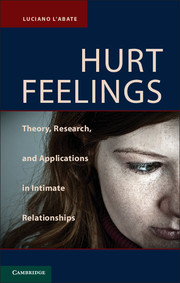Book contents
- Frontmatter
- Contents
- Preface
- Acknowledgments
- Introduction
- Part One Background
- Part Two The Scientific Bases of Hurt Feelings
- 6 The Discovery of Hurt Feelings
- 7 Biological Processes Underlying Hurt Feelings
- 8 Gender and Individual Differences in Hurt Feelings
- 9 Cultural Differences in Hurt Feelings
- 10 The Psychopathology of Hurt Feelings
- Part Three Applications of Hurt Feelings in Mental Health
- Part Four Models of Hurt Feelings In Theory and Applications
- Appendix A An Informed Consent Form to Deal with Hurt Feelings
- Appendix B Experimental Scale of Unexpressed Hurt Feelings
- References
- Author Index
- Subject Index
6 - The Discovery of Hurt Feelings
The Pioneers
from Part Two - The Scientific Bases of Hurt Feelings
Published online by Cambridge University Press: 05 June 2012
- Frontmatter
- Contents
- Preface
- Acknowledgments
- Introduction
- Part One Background
- Part Two The Scientific Bases of Hurt Feelings
- 6 The Discovery of Hurt Feelings
- 7 Biological Processes Underlying Hurt Feelings
- 8 Gender and Individual Differences in Hurt Feelings
- 9 Cultural Differences in Hurt Feelings
- 10 The Psychopathology of Hurt Feelings
- Part Three Applications of Hurt Feelings in Mental Health
- Part Four Models of Hurt Feelings In Theory and Applications
- Appendix A An Informed Consent Form to Deal with Hurt Feelings
- Appendix B Experimental Scale of Unexpressed Hurt Feelings
- References
- Author Index
- Subject Index
Summary
Mace’s (1976) arguments concerning the love-anger cycle in marriage are criticized on philosophical (theoretical) and technical (clinical) grounds. Underneath the smoke screen of anger there is the fire of hurt feelings. Dealing with these feelings decreases the expression of anger and helps the couple reach “real” intimacy: the sharing of hurt feelings. Victories we can share with anybody. Anybody is willing to share victories with us. Hurt feelings, on the other hand, belong within the marriage.
L’Abate (1977, p. 13)
This admittedly self-serving introductory quote is reprinted to proffer a chronological timeline to the study of hurt feelings. This quote was followed up by a specific study by Frey, Holley, and L’Abate (1979), who found that couples liked a sharing-of-hurts scenario better than two other scenarios. Because I cannot think of any other way to organize pioneers about the study of hurt feelings except chronologically, this is the way pioneers in the study of hurt feelings will be presented within and among themselves.
Edward M. Waring
This Canadian physician/psychiatrist wrote about “intimacy” rather than specifically on hurt feelings. Nonetheless, his contribution is worth inclusion as a pioneering study of intimacy, if not hurt feelings (Waring, McElrath, Mitchell, & Derry, 1981). He has been ignored by the emotion and intimacy literature, even though his work deserves relevant coverage. For example, in a whole series of studies summarized herein, Waring, Tillman, Frelick, and Russell (1980), in an open-ended format, questioned fifty adults in the general population regarding their concepts of intimacy. A second random sample of twenty-four couples from the general population and twenty-four clinical couples received a standardized interview in which concepts of intimacy were systematically rated to develop an operational definition of the dimensions of intimacy.
- Type
- Chapter
- Information
- Hurt FeelingsTheory, Research, and Applications in Intimate Relationships, pp. 129 - 142Publisher: Cambridge University PressPrint publication year: 2011



